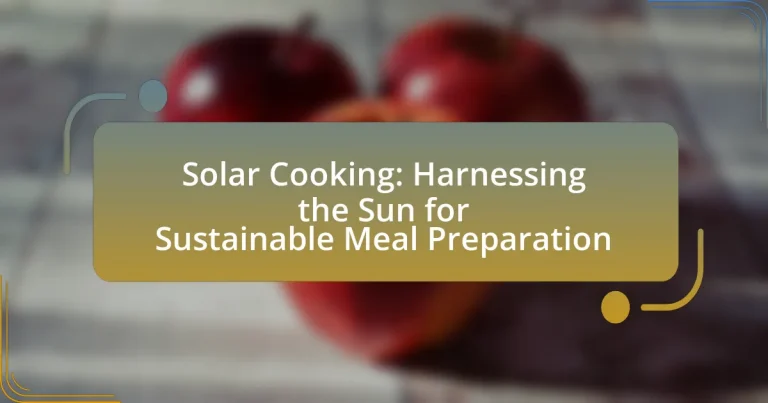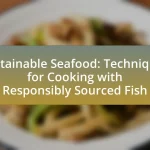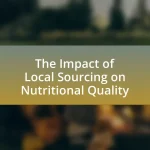Solar cooking is a method of preparing food using sunlight as the primary energy source, utilizing solar cookers designed to concentrate sunlight for cooking. This article explores the mechanics of solar cooking, including the various designs of solar cookers such as box, panel, and parabolic cookers, and their impact on cooking efficiency. It highlights the environmental benefits of solar cooking, including reduced reliance on fossil fuels, decreased greenhouse gas emissions, and improved health outcomes by minimizing indoor air pollution. Additionally, the article discusses practical tips for effective solar cooking, the challenges faced, and resources available for further learning, emphasizing the importance of community support in promoting sustainable cooking practices.
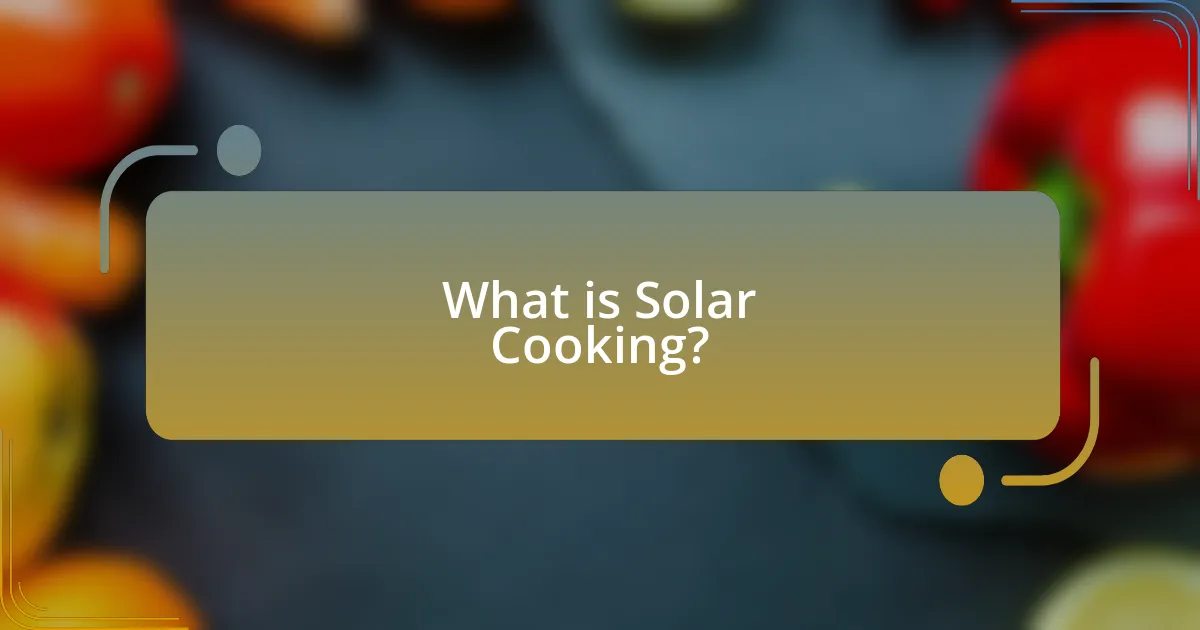
What is Solar Cooking?
Solar cooking is a method of preparing food using sunlight as the primary energy source. This technique utilizes solar cookers, which are devices designed to concentrate sunlight to generate heat for cooking. Solar cooking is recognized for its environmental benefits, as it reduces reliance on fossil fuels and minimizes indoor air pollution associated with traditional cooking methods. According to the Solar Cookers International organization, solar cooking can significantly decrease deforestation and greenhouse gas emissions, making it a sustainable option for meal preparation.
How does solar cooking work?
Solar cooking works by using sunlight to heat food through various designs that concentrate or capture solar energy. Solar cookers typically utilize reflective surfaces to direct sunlight onto a cooking pot, which absorbs the heat and cooks the food inside. For example, parabolic solar cookers focus sunlight onto a single point, achieving high temperatures suitable for boiling or frying, while box cookers trap heat within an insulated chamber, allowing for slower cooking methods. The effectiveness of solar cooking is supported by studies showing that solar cookers can reach temperatures of up to 200 degrees Celsius, making them viable for cooking a variety of meals.
What are the main components of a solar cooker?
The main components of a solar cooker include a reflective surface, a cooking chamber, and a transparent cover. The reflective surface, often made of aluminum or mirrors, concentrates sunlight onto the cooking chamber, which is designed to retain heat. The transparent cover, typically made of glass or clear plastic, traps heat inside the cooking chamber, enhancing the cooking process. These components work together to effectively harness solar energy for cooking, making solar cookers an efficient and sustainable cooking solution.
How do different designs of solar cookers affect cooking efficiency?
Different designs of solar cookers significantly affect cooking efficiency by influencing heat absorption, retention, and distribution. For instance, parabolic solar cookers concentrate sunlight onto a single point, achieving higher temperatures and faster cooking times compared to box cookers, which rely on passive solar heating and generally operate at lower temperatures. Research indicates that parabolic cookers can reach temperatures of up to 200 degrees Celsius, while box cookers typically peak around 120 degrees Celsius. Additionally, the materials used in construction, such as reflective surfaces and insulation, further enhance the efficiency of solar cookers by minimizing heat loss. Therefore, the design and materials directly correlate with the cooking efficiency of solar cookers.
What are the benefits of solar cooking?
Solar cooking offers numerous benefits, including environmental sustainability, cost savings, and health advantages. By utilizing sunlight as a cooking energy source, solar cooking reduces reliance on fossil fuels, thereby decreasing greenhouse gas emissions and contributing to climate change mitigation. Additionally, solar cookers can lower energy costs, as they do not require fuel purchases, making them economically advantageous for users. Health benefits arise from solar cooking, as it minimizes the risk of indoor air pollution associated with traditional cooking methods that use solid fuels, which can lead to respiratory issues. Furthermore, solar cooking can preserve nutrients in food better than some conventional cooking methods, enhancing the nutritional value of meals.
How does solar cooking contribute to sustainability?
Solar cooking contributes to sustainability by utilizing renewable solar energy to prepare food, thereby reducing reliance on fossil fuels and minimizing greenhouse gas emissions. This method of cooking not only conserves energy but also decreases deforestation, as it eliminates the need for firewood, which is often sourced unsustainably. According to a study by the United Nations Environment Programme, solar cooking can reduce carbon dioxide emissions by up to 1.5 tons per household annually, highlighting its significant impact on environmental sustainability.
What health benefits are associated with solar cooking?
Solar cooking offers several health benefits, primarily by reducing exposure to harmful pollutants. Traditional cooking methods often involve burning wood or fossil fuels, which release smoke and particulate matter that can lead to respiratory issues and other health problems. In contrast, solar cooking utilizes sunlight as a clean energy source, significantly decreasing indoor air pollution. Studies indicate that households using solar cookers report fewer respiratory illnesses and improved overall health outcomes. Additionally, solar cooking preserves the nutritional quality of food better than some conventional methods, as it often involves lower cooking temperatures and reduced cooking times, which can help retain vitamins and minerals.
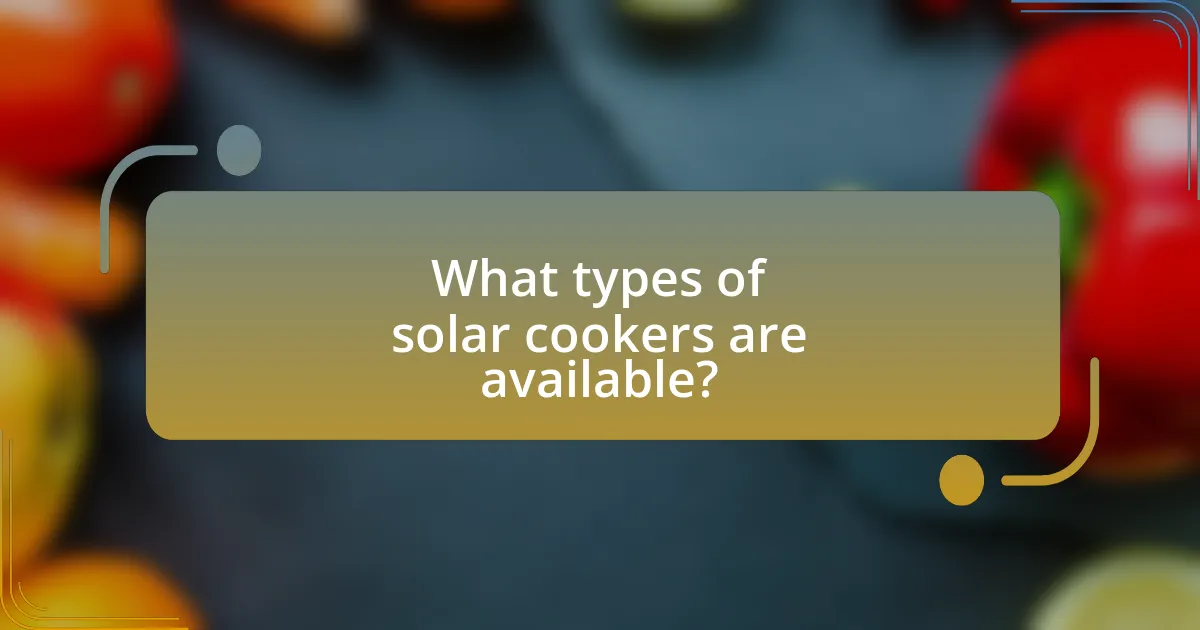
What types of solar cookers are available?
There are three main types of solar cookers: box cookers, panel cookers, and parabolic cookers. Box cookers are insulated boxes that trap heat, allowing food to cook slowly over time. Panel cookers use reflective panels to direct sunlight onto a cooking pot, achieving moderate temperatures suitable for baking or boiling. Parabolic cookers consist of a curved reflective surface that focuses sunlight onto a single point, generating high temperatures ideal for frying or grilling. Each type utilizes solar energy effectively, making them viable options for sustainable meal preparation.
How do box cookers differ from panel cookers?
Box cookers differ from panel cookers primarily in their design and heat retention capabilities. Box cookers are insulated, enclosed structures that trap heat, allowing for higher cooking temperatures and longer cooking times, while panel cookers utilize reflective panels to direct sunlight into a cooking pot, relying on direct sunlight and generally achieving lower temperatures. The insulation in box cookers can maintain heat for several hours, making them suitable for slow cooking, whereas panel cookers are more dependent on immediate sunlight and are typically used for shorter cooking durations.
What are the advantages of using a box cooker?
The advantages of using a box cooker include energy efficiency, cost-effectiveness, and environmental sustainability. Box cookers utilize solar energy to cook food, which reduces reliance on fossil fuels and lowers energy costs. According to the Solar Cookers International, solar cooking can save up to 1.5 tons of firewood per family per year, significantly decreasing deforestation and carbon emissions. Additionally, box cookers are simple to construct and operate, making them accessible for various communities, especially in regions with abundant sunlight.
In what scenarios are panel cookers most effective?
Panel cookers are most effective in sunny, clear weather conditions where direct sunlight is abundant. These cookers utilize reflective surfaces to concentrate sunlight onto a cooking pot, achieving high temperatures suitable for cooking. Research indicates that panel cookers can reach temperatures of up to 200 degrees Celsius in optimal conditions, making them ideal for cooking meals during the day in regions with consistent sunlight. Additionally, they are particularly useful in remote areas without access to conventional fuel sources, providing a sustainable cooking solution that reduces reliance on fossil fuels.
What factors should be considered when choosing a solar cooker?
When choosing a solar cooker, factors such as design type, cooking efficiency, portability, and material quality should be considered. The design type, including box cookers, parabolic cookers, and panel cookers, affects cooking speed and temperature. Cooking efficiency is crucial, as some models can reach higher temperatures faster, impacting meal preparation time. Portability matters for users who need to transport the cooker, especially for outdoor use. Lastly, the material quality influences durability and heat retention, with materials like glass and metal providing better performance. These considerations ensure optimal use and satisfaction with the solar cooking experience.
How does climate influence the effectiveness of solar cooking?
Climate significantly influences the effectiveness of solar cooking by determining the availability and intensity of sunlight. Regions with high solar radiation, such as deserts, enable solar cookers to reach higher temperatures and cook food more efficiently, while areas with frequent cloud cover or rain reduce the effectiveness of solar cooking due to diminished sunlight exposure. For instance, studies show that solar cookers can achieve cooking temperatures of 100°C or more in sunny climates, whereas in overcast conditions, temperatures may drop significantly, hindering the cooking process.
What size and capacity should be considered for a solar cooker?
The size and capacity of a solar cooker should be determined based on the number of people being served and the types of meals being prepared. A typical solar cooker has a cooking area ranging from 1 to 3 square feet, which can accommodate pots of various sizes. For example, a solar cooker with a capacity of 2 square feet can effectively cook meals for 4 to 6 people, while larger models can serve more. The design should also consider the type of food; larger pots or multiple smaller pots may be needed for stews or larger meals. Additionally, the efficiency of the cooker is influenced by its reflective surface area and insulation, which can impact cooking times and temperature retention.
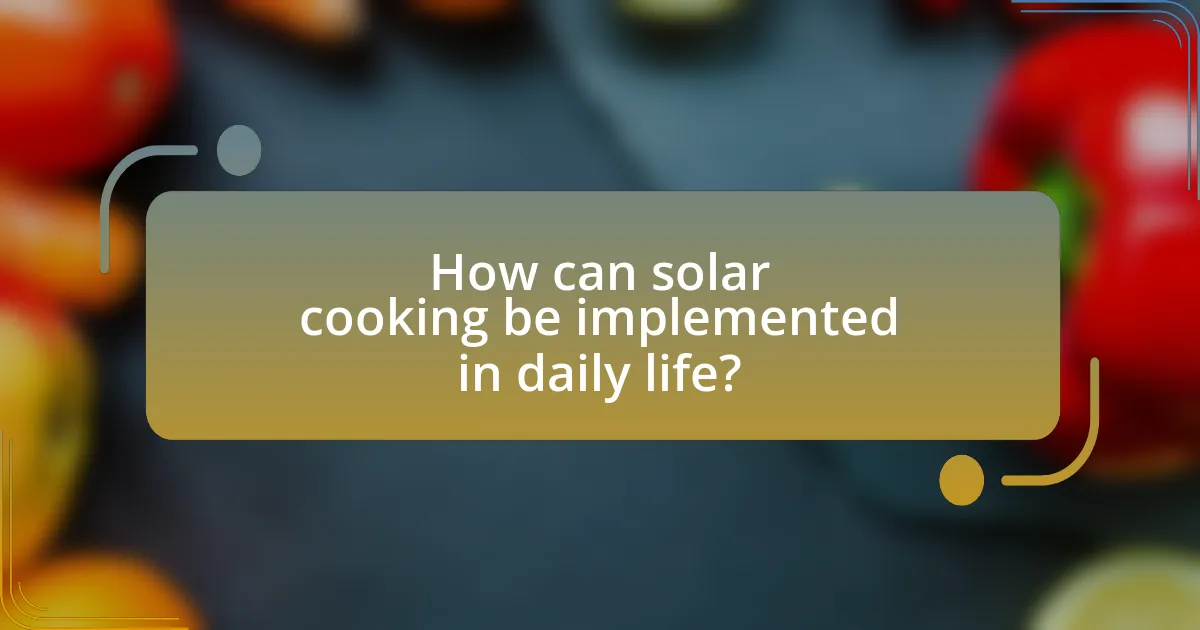
How can solar cooking be implemented in daily life?
Solar cooking can be implemented in daily life by utilizing solar cookers, which harness sunlight to cook food. These cookers can be used in various settings, such as homes, schools, and community centers, allowing individuals to prepare meals without relying on conventional energy sources. For instance, solar cookers can reach temperatures sufficient for cooking rice, baking bread, or boiling water, making them versatile tools for meal preparation. Studies have shown that solar cooking can reduce fuel consumption and lower greenhouse gas emissions, contributing to environmental sustainability. Additionally, solar cookers are cost-effective, as they require minimal maintenance and can be constructed from readily available materials, making them accessible for many households.
What are some practical tips for using a solar cooker?
To effectively use a solar cooker, position it to face the sun directly, ensuring maximum sunlight exposure for optimal cooking temperatures. Additionally, use dark, non-reflective cookware to absorb heat efficiently, as darker surfaces retain heat better than lighter ones. It is also beneficial to preheat the solar cooker by allowing it to warm up for 30 minutes before placing food inside, which can enhance cooking performance. Furthermore, cover the food with a transparent lid to trap heat and moisture, promoting even cooking. Lastly, monitor the cooking process periodically, adjusting the cooker’s angle as the sun moves to maintain direct sunlight exposure. These practices are supported by the fact that solar cookers can reach temperatures of up to 350°F (175°C) under ideal conditions, making them effective for various cooking methods.
How can meal planning enhance the use of solar cooking?
Meal planning enhances the use of solar cooking by optimizing the timing and selection of meals that can be effectively prepared using solar energy. By planning meals in advance, individuals can choose recipes that align with the solar cooking process, which requires specific cooking times and temperatures that vary throughout the day based on sunlight availability. For instance, meals that require longer cooking times can be scheduled during peak sunlight hours, maximizing the efficiency of solar cookers. Additionally, meal planning allows for the preparation of dishes that can be cooked simultaneously, reducing energy waste and ensuring that all available solar energy is utilized effectively. This strategic approach not only improves the cooking experience but also promotes sustainable practices by reducing reliance on conventional energy sources.
What common mistakes should be avoided when solar cooking?
Common mistakes to avoid when solar cooking include using inadequate solar cookers, failing to position the cooker correctly, and not preheating the cooking vessel. Inadequate solar cookers may not capture enough sunlight, leading to inefficient cooking. Incorrect positioning can result in reduced solar exposure, significantly impacting cooking times. Additionally, neglecting to preheat the cooking vessel can prolong cooking duration and affect food quality. These mistakes can hinder the effectiveness of solar cooking, making it less efficient and practical for meal preparation.
What are the challenges of solar cooking?
The challenges of solar cooking include dependence on sunlight, limited cooking times, and the need for specific equipment. Solar cooking relies heavily on direct sunlight, making it ineffective during cloudy weather or at night, which restricts its usability. Additionally, solar cookers often require longer cooking times compared to conventional methods, which can be inconvenient for users. Furthermore, the effectiveness of solar cookers can vary based on design and materials, necessitating proper selection and maintenance to ensure optimal performance. These factors collectively hinder widespread adoption and practical use of solar cooking technologies.
How can weather conditions impact solar cooking?
Weather conditions significantly impact solar cooking by influencing the amount of sunlight available for the cooking process. For instance, clear skies with direct sunlight enhance the efficiency of solar cookers, allowing them to reach higher temperatures and cook food more effectively. Conversely, cloudy or rainy weather reduces sunlight exposure, leading to lower cooking temperatures and longer cooking times. Research indicates that solar cookers can achieve optimal performance on sunny days, with temperatures exceeding 200 degrees Fahrenheit, while overcast conditions can drop these temperatures significantly, making effective cooking challenging.
What solutions exist for overcoming limitations in solar cooking?
Solutions for overcoming limitations in solar cooking include the use of improved solar cooker designs, such as parabolic cookers that concentrate sunlight more effectively, and the integration of thermal storage systems that allow cooking even when sunlight is not available. Enhanced materials, like reflective surfaces and insulated cooking chambers, increase efficiency and heat retention. Additionally, education and training on optimal usage and maintenance of solar cookers can significantly improve their effectiveness. Research indicates that these advancements can lead to higher cooking temperatures and reduced cooking times, making solar cooking a more viable option for diverse culinary needs.
What resources are available for learning more about solar cooking?
Resources for learning more about solar cooking include books, online courses, and websites dedicated to the subject. Notable books such as “The Solar Cooking Book” by the Solar Cookers International provide comprehensive guides on techniques and designs. Online platforms like Coursera and Udemy offer courses on solar cooking principles and applications. Additionally, websites such as Solar Cookers International and the Solar Cooking Wiki provide extensive information, tutorials, and community support for enthusiasts. These resources collectively offer a solid foundation for anyone interested in exploring solar cooking.
Where can one find solar cooking recipes and guides?
One can find solar cooking recipes and guides on various websites dedicated to sustainable cooking and renewable energy. Notable resources include the Solar Cookers International website, which offers a range of recipes and instructional materials specifically for solar cooking. Additionally, the book “The Solar Cookbook” by the Solar Cooking Community provides a comprehensive collection of recipes and techniques. These sources are validated by their focus on promoting solar cooking as an eco-friendly cooking method, making them reliable for anyone interested in this sustainable practice.
How can community programs support solar cooking initiatives?
Community programs can support solar cooking initiatives by providing education, resources, and infrastructure. These programs can organize workshops to teach community members how to build and use solar cookers effectively, enhancing local knowledge and skills. Additionally, community programs can facilitate access to materials needed for constructing solar cookers, thereby reducing barriers to participation. For instance, a study by the Solar Cookers International found that communities with organized support saw a 40% increase in solar cooker usage, demonstrating the effectiveness of structured community involvement in promoting sustainable cooking practices.
What are the best practices for successful solar cooking?
The best practices for successful solar cooking include selecting the right solar cooker, positioning it correctly, using appropriate cookware, and monitoring cooking times. A well-designed solar cooker, such as a parabolic or box cooker, maximizes sunlight absorption and heat retention. Proper positioning involves placing the cooker in direct sunlight, ideally facing the sun to capture maximum solar energy throughout the day. Using dark, heat-absorbing cookware enhances cooking efficiency, as it absorbs more heat. Additionally, monitoring cooking times is crucial, as solar cooking can take longer than conventional methods; understanding the specific cooking times for different foods ensures optimal results. These practices are supported by studies indicating that effective solar cooking can reduce fuel consumption and lower greenhouse gas emissions, making it a sustainable cooking method.
